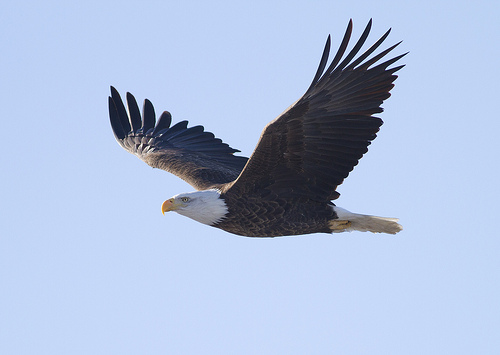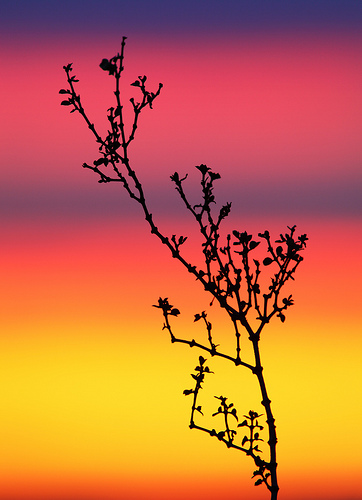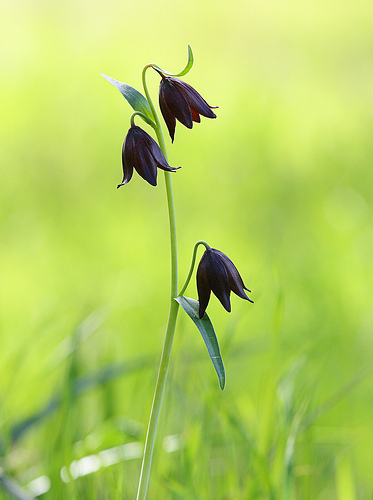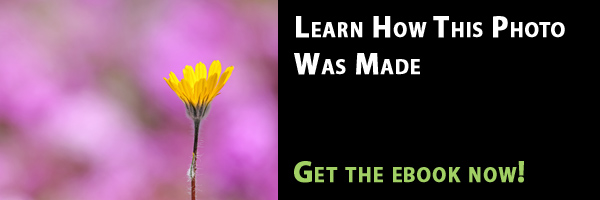 Do you ever wish you could add something to your nature photos that would just magically make them all super awesome and fantastic?
Do you ever wish you could add something to your nature photos that would just magically make them all super awesome and fantastic?
Well, guess what? You can!
That secret ingredient is patience.
One of the hardest parts about photographing nature is that nature is filled with uncontrollable subjects.
That flower will grow where it feels like, not where you want it to grow (in front of a beautiful background).
That bird will perch where he or she feels like it, not where you want it to perch (in that perfect light).
That mountain is not moving–regardless of how much you want to put it in front of your favorite lake to create a nice reflection image.
So, the only way to deal with all this uncontrollable chaos is patience.
Here’s a few stories to help illustrate the importance of patience:
Bald Eagle in Flight

To get this photo of a bald eagle in flight, I had to stand in 5 degree weather for about two hours. Although there were a ton of eagles flying around, only occasionally did they fly close enough to photograph (filling at least 20% of the frame). I’d say for the two hours my dad and I were outside, I probably only had a minute or two of pressing the shutter. For the other 118 minutes, we just waited patiently for those birds to fly closer.
Silhouette of a Creosote Branch

To photograph this silhouette of a creosote bush, three things needed to happen: a good sunrise or sunset, low wind, and I needed to find a good branch to photograph.
In the desert, good sunrises and sunsets are pretty common, so that wasn’t much of a problem. But, it’s usually pretty windy, and these creosote bushes really like to bounce in the air (even on the calmest of days), so I had to wait awhile for that calm day.
Lastly, I needed to find a good branch to photograph: one that pointed almost straight up and didn’t bunch up a lot in any part. Creosote branches tend to grow more parallel to the ground, so it took some time to find a nice branch like this.
Chocolate Lily

To get this photo of a Chocolate Lily, I spent hours looking for a flower with a great background (one that was far away and contrasted well with the brown flowers). And, then once I found this specific flower, I waited patiently for about 30 minutes until a cloud came in to block the sun and help balance the light on the flower.
What about you?
If you have a similar story to share about how patience played a big role in one of your photos, please share it with us by leaving a comment below.
Please post a link to your photo too, if possible. Thanks! 🙂
If you enjoyed this article, and would like to read more, please signup for free updates by email or RSS.
 About the Author: Steve Berardi is a naturalist, photographer, computer scientist, and founder of PhotoNaturalist. You can usually find him hiking in the beautiful mountains and deserts of Southern California.
About the Author: Steve Berardi is a naturalist, photographer, computer scientist, and founder of PhotoNaturalist. You can usually find him hiking in the beautiful mountains and deserts of Southern California.

Nice post. Very helpful. Thanks.
I spent 2+ hours Standing in a corner of the Pannes to capture this image of a black-necked stilt in flighthttp://www.flickr.com/photos/photobee1/5797545230/
Great advice. I can’t count how many times I’ve stood quietly waiting for a critter to get close or turn a certain way. I’ll spend 2-3 hours a day at the same spot. People walk up look about, don’t see anything, then leave. It almost never fails. 5 minutes after they leave, something cool happens: the osprey flies over with a fish, the deer fawn walks out, the clouds explode with color. It’s always something.
Thanks Steve for a very helpfull article. One hears stories like these but it sure brings the point across with examples like yours.
I absolutely agree about the need for patience. I have two examples to add to yours.
This one of Horsehoe Bend on the Colorado River near Page, Arizona.
http://fineartamerica.com/featured/horseshoe-bend-phil-stone.html
I waited over 2 hours for the clouds to move so that I could avoid shadows on the rocks in the centre of the photo. All that time I was hanging over the edge with my camera on the end of a tripod to give me the longest reach possible to try to avoid the foreground rocks.
And this one of a Roseate Spoonbill
http://fineartamerica.com/featured/roseate-spoonbill-in-flight-phil-stone.html
I was watching the Roseates for well over an hour trying to shoot one in flight with a good background. I was just starting to run out of patience when this one came into view from a distance and flew past me – giving me plenty of time to manage my position to get the background and the exposure “just so”.
Patience well rewarded in both instances – I hope you will agree.
Good information. Must be something to the element of patience and nature photography, as I have read two other articles on the subject this week.
The attached link is to a hummingbird photo that I took in Colorado. You don’t have to be real patient to attract the little guys but to get them to hold still in a position where the back ground and composition is adequate takes some time. I think I sat there for about 2 hours to get this photo. Took dozens of others but I like the bird against these background colors the best.
http://www.flickr.com/photos/troutwhisperer/5765521485/
This was the day that my (new) camera and I became friends. I’d bought it a couple months earlier, but we didn’t quite find our rhythm until I sat by the bank of Steamboat Creek, just off the Umpqua River, Oregon.
I sat for a little over 3 hours watching about 200 wild steelhead in a pool; they moved with the shadows and scattered when (first a mink, then an osprey and sometimes the hiker meandering through) movement occurred. And then, late afternoon, they began jumping.
A perfect moment, and in perfect rhythm.
http://humbirdhum.wordpress.com/2010/08/11/first-day-of-vacation/
Great article and yes i agree patience is key to making your own luck
Here’s my story of trying to get a closeup of a Belted Kingfisher
I spent 1.5 hours dressed in camouflage and fighting off black flies hiding under a spruce tree, waiting for a kingfisher to land on a post i’d placed in a small pond. Just when i was about to give up i heard a splash in the water about 10 feet away and saw a kingfisher heading for the post i’d setup. I raised my camera and we were both looking at each other, i took one shot and he took off with his minnow.
This is the only shot i got
Link http://www.flickr.com/photos/markusclement/5703794483/in/photostream
Regards
Markus
Thanks everyone for sharing your great stories! It’s amazing what you’ll see if you just sit somewhere and wait for a few hours 😉
“Adopt the pace of nature: her secret is patience.” –Ralph Waldo Emerson
**Thanks to Steve Fisher for sharing this quote on our Facebook page 🙂
indeed! PATIENCE IS A VIRTUE
The counter-point to patience is remaining aware of all of your surroundings and being ready to react to the unexpected. You might be all zoomed in and setup on a nest waiting for the mom to return and feed the babies. But, if you don’t watch all around you, you might miss the snake stalking a cricket off to your left. Some of my best shots have been “grabbed” when something happened nearby. I usually keep a second camera with me mounted with a 70-300 VR lens for just such moments.
Pete – that’s a really excellent point. In fact, I think I’ll have to write a blog post about that 🙂 I’ve missed out on a lot of photos by paying too much attention to one small area. Being prepared for anything (anywhere) is super important.
Hey Steve… Great article & above all great observation. We wait for a good frame… but many a times we don’t realize what we did to get it. The virtue of patience is inherent to good photography. Thanks a lot.. here’s a click of a butterfly.. I took a year back.. which satisfied me a lot.. especially because I waited for about 30 mins for this frame.
http://www.flickr.com/photos/sumoka/5997181846/in/photostream
Suyog.
@Suyog – Great photo! Definitely worth the wait 🙂
@Steve – looking @ your favorites list… I feel really proud for taking this pic. That’s mighty encouraging thanks.
Thanks Steve. I had a burning passion to do something delightfully creative and set off to a local National Park having no idea what I would photograph. After stumbling about in the bush for 2 hours and over granite boulders the light on a small creek of fast flowing water captured my imagination. I sensed victory, and experimented with my CP filter. I thought I was successful but never appreciated its full extent until I downloaded. The stream was bent over a smooth rock bed where the water flowed down and turned up again before it broke. Light patterns and layers of light presented, resulting from different light directions presented to the CP filter. An exercise in patience and a valuable lesson in understanding that because a CP filter covers the whole lens it does not affect the whole of the picture equally.
Ken – great story! Thanks for sharing 🙂 And, I like your photos of the stream (especially that first one with all the green).
Great article Steve. I was exploring a dry river bed one morning and not getting a lot of results. My feet and my stomach were ready to leave but I convinced myself to try just a little further when I met this little fellow.
http://www.flickr.com/photos/craigj72/6115074670/in/photostream/lightbox/
I think I spent about an hour and a half waiting for the chance to get this shot of the Osprey leaving the nest in the middle of an orchard. Spent some of that time following them around between the nest and their favorite perching tree on the far side of the road from the orchard though getting other shots. I considered myself lucky to get this shot at all while hand holding a 500mm manual lens though. https://plus.google.com/105226830752439745179/posts/h18Q32DY55G